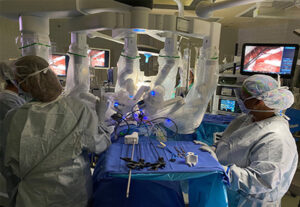
Story by D. Keith Johnson
Columbia VA Health Care System
COLUMBIA, South Carolina – The Columbia VA Health Care System robotic surgery teams recently completed their 800th robotic surgery and the numbers are increasing every day. The 800th occurred in mid-April, and the teams are on schedule to hit 1000 by the end of the year.
CVAHCS started using the robotic surgical system in January 2020 for general and thoracic surgeries. Orthopedic surgeries were added in September 2023 and gynecological surgeries in October 2023. The current total is approximately 850 surgeries and there are approximately 22-25 surgeries performed per month. CVAHCS currently leads VISN-7 in percentage of robotic surgeries.
“Because robotic surgery is more precise, there is less trauma to the soft tissue,” said Dr. Nael Alghothani, the acting chief of surgery. He has been involved with the CVAHCS robotic surgeries since the beginning. “Although the surgery may take longer, the effects afterwards are minimal, which results in less pain after the surgery, less time for recovery and shorter rehab.”
The CVAHCS teams make that possible with the Da Vinci XI robotic surgical system for general, thoracic and gynecological surgeries. Additionally, the ortho department started accomplishing knee surgeries in September 2023 with the ROSA, or Robotic Surgical Assistant system.
“We currently use it for knees only,” said Dr. John Chu, chief of orthopedics. The ROSA can also be used for anterior hips and for shoulder replacements, however, neither are currently performed at CVAHCS.
“It allows fine tuning in the balancing of the knee prior to any bone cuts with hopes of improved function and longevity of the implants,” said Chu. “We are approaching 100 robotic assisted cases and both the surgeons and patients have been very happy with the results.”
Robotic surgery has come a long way in the last 10 years and crosses almost all surgical subspecialties. It continues to evolve as surgeons become more and more comfortable with this technology.
Dr. Ana Rodriguez joined CVAHCS in October 2023 as a Gynecologist/Minimally Invasive Gynecologic Surgeon. She performed her first robotic-assisted surgery in 2011. “To me every surgery is interesting and unique,” she said. “My clinical interests involve the study of both the medical and epidemiological aspects of gynecologic cancer prevention and control, particularly HPV-related diseases and cancer.”
She was a tenured professor at the University of Texas Medical Branch in Galveston where she was training the new generation of gynecologists in robotic surgery. As of July 12, 2024, Rodriguez has performed 30 robotic surgeries at CVAHCS.
The surgeons who use the robot must complete a formalized credentialing plan, which includes simulation training, hands-on cadaver lab training and case proctoring. Additionally, the surgeon must perform a number of cases over a two-year period to maintain their credentials.
“I think we still have progress to make,” added Alghothani. “We are focusing on recruiting a urologist. Robotic urology surgeries are the standard now.”
With robotic surgeries, Veterans can receive minimally invasive procedures with incredible precision and quicker recoveries. What used to require invasive surgery now only needs small paper-clip sized incisions to insert the surgical system. Surgeries that in the past required weeks of recovery now only require a few days.